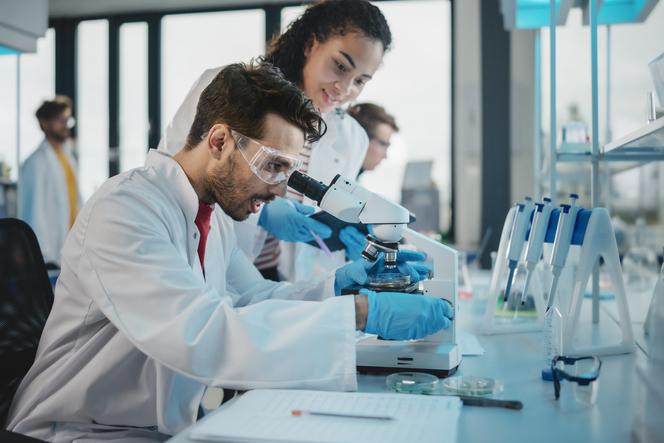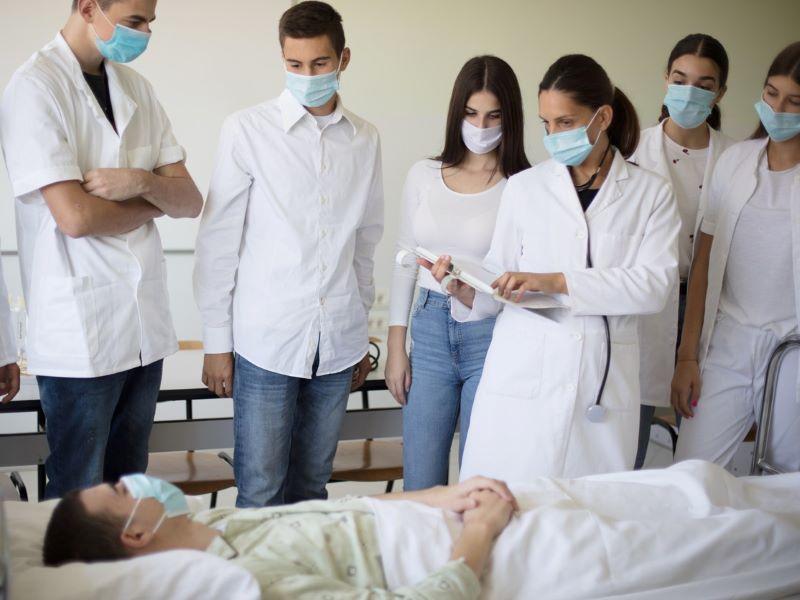What are the students in your classroom doing? How does this match what they will be doing in the professional workplace? Educators of healthcare professionals and other vocational qualifications have been asking similar questions for some time: after all, we’d like our doctors, pharmacists and social workers (to name a few) to be able to do before we meet them as a client.
We asked ourselves these questions five years ago when we were part of the team designing a new MSc course in drug discovery at the University of Bath. Feedback from industrial reviewers prior to course approval was unambiguous: “A key aspect of the drug-discovery and development process is that it is a multidisciplinary team working together for a common goal.”
Hmm. That didn’t sound like a traditional lecture room or practical class – but it did sound fun.
- Building the future: the case for inter-faculty learning
- Implementing project-based learning: a practical guide
- Using immersive tech to enrich healthcare education
So we set ourselves a brief: how can we teach students to work across traditional disciplinary boundaries and make industrially relevant scientific decisions in a creative – and hopefully enjoyable – manner? In particular, how can we do this in an experimental scenario when carrying out the experiments themselves would be far beyond the time and budget of the course?
Competing priorities and creative science in a data-driven drug-discovery scenario
Our solution is set within a design-make-test-analyse (DMTA) scenario from early-stage drug discovery. In industry, biological assays are used to inform the design of chemical compounds (early-stage potential drugs), which are in turn tested and provide the data to underpin the next round of chemical design. This process is iterated until a molecule that possesses properties indicative of a future medicine is developed.
To replicate this process, we provide teams of students with data from a fictional biological screen, outline realistic success criteria for the end of the project and give the students a week to design four new compounds. Students also need to choose an experimental assay for each compound and rationalise their decisions. The limits here are student imagination and the need to rationalise their choices using good scientific logic. Our task is to respond to the student work with appropriate physical parameters for each of the new compounds and simulate the requested data before the next workshop – in which the data is analysed and a new round of DMTA is begun.
Over the course of five workshops, there is a lot of discussion and the students build up a portfolio of evidence in favour of a final candidate drug. Our students have a range of backgrounds – chemistry, biology, pharmacy – and the task requires them to use their core expertise and communicate with their peers to meet the common goal.
As in the real world, decisions made by the students are “messy” and trade-offs are needed. If students optimise binding to their protein target, does this mean potential drugs might not get into biological cells? If a potential drug is soluble in water, does this come at the price of being modified by the body and becoming ineffective? This is different from other assignments and students find it hard. It’s also what makes our approach valuable.
Positive responses from students and industry colleagues
“This coursework exercise was really interesting and challenging,” wrote a member of the 2020-21 cohort of students in post-submission feedback.
“Using what I learned from the lectures was very useful as I realised the parts that I hadn’t understood, before,” agreed another student, who studied in 2019-20. “That was one of my best experiences for a group working.”
We’ve also had a positive response from our colleagues in the pharmaceutical industry.
“This…is an innovative way to give students practical experience of key drug-discovery skills and effectively prepare them for the world of work,” said Matthew Thomas, head of immunology and respiratory research at Boehringer Ingelheim.
“Real understanding of the complexities and challenges of drug discovery cannot be fully appreciated from lecture courses alone,” said Andy Merritt, an experienced medicinal chemist from LifeArc, who also runs immersive training as part of a Royal Society of Chemistry summer school. “It is in the application of the concepts to real-time examples that full understanding develops.” We agree.
Recently, we drew our experiences together and described the exercise in a paper for the Journal of Chemical Education. By making a naive attempt to simulate the industrial project team, we’ve moved from teacher-centred learning to an authentic approach. We now have hands-on data handling, team-building and technical knowledge acquisition ─ all while doing good science within an industrially relevant scenario. We think this kind of teaching offers clear benefits for students, employers and staff, too. We’d like our students to be good scientists, not to simply be good at writing essays about the topic.
Top tips for implementing a data-based drug-discovery exercise
- Upskill your students in the relevant software in advance: We require students to manipulate protein structures, fit assay data, draw chemical structures and dock small molecules into a pre-prepared protein target. Each of these uses a common but specialised computer software package, and students are much more comfortable if they can focus on the scientific questions of drug discovery during the teaching exercise rather than having to learn scientific software alongside this. We timetable a hands-on software workshop for each package during the preceding semester and explicitly link completion of the workshop to the next semester’s work. Ensuring that software packages are free – or that site licences cover personal machines – means that students can carry out preparatory work both on and off campus.
- Ensure students submit all files electronically: Much of the calculated or simulated data we provide to students is based on a proxy parameter generated by an online server. Re-drawing student requests takes time, even for experienced users, and errors and inconsistencies creep in when chemical structures are copied from a PDF or Word submission.
- Have your cheat sheet to hand and be willing to learn quickly: Simulating data itself is surprisingly quick; the slow part is working out how to simulate the results of a particular assay. Make a cheat sheet (or download mine). If a student comes up with a new assay request, it is likely that it is taught somewhere on the course or can easily be googled (for very precise requests, ask the students for the reference). Remember, you don’t need to review the merits of each assay and make a scientific judgement about it – just grasp the broad outline and decide what “high” and “low” responses look like (and where the student compound is likely to lie between these).
- Don’t be afraid to send back poor student requests: Data preparation becomes a chore when students are disorganised or make poor requests. Unless you think that this reflects poor software skills (and that students need more support), don’t take responsibility for organising the students – this is one of the professional skills that the team needs to learn.
- Enjoy it: This is learning by doing, and the process is part of the learning. Let’s have fun!
Charlotte Dodson is a senior lecturer in the department of life sciences and Steve Flower is a lecturer in the department of chemistry; both are at the University of Bath.
If you would like advice and insight from academics and university staff delivered direct to your inbox each week, sign up for the Campus newsletter.




comment